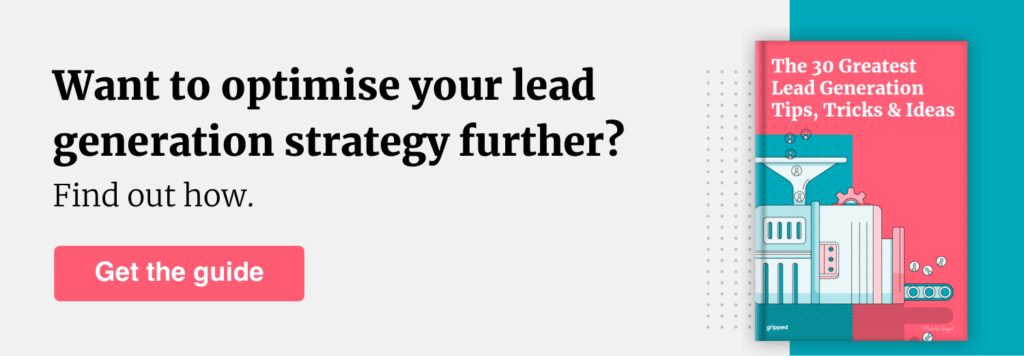Is your SaaS company’s current lead generation strategy effective?
If not, then chances are that you’re struggling to grow — or even worse, slowly limping towards a crisis. That’s because your business can only thrive if you’re able to consistently draw in new potential customers.
For SaaS companies in particular, lead generation is tricky. SaaS businesses aren’t selling a physical product, and as a result, consumers have ample time to read reviews, watch YouTube videos, and ask for word-of-mouth recommendations before they make a purchasing decision.
What’s more, the SaaS industry generally has low barriers of entry — a trend that makes the market saturated and therefore extremely competitive. So, for SaaS companies, simple lead nurturing alone is not enough — you need to optimise your lead generation strategy in order to lure qualified leads and drive continual growth.
In this article, we’ll look at how you can do just that by examining the steps required to craft an effective SaaS lead generation strategy. Ready? Let’s get started.
#1 Set SMART goals
The first step to optimising your lead generation strategy is to set SMART goals. SMART is a commonly used acronym to describe Specific, Measurable, Attainable, Relevant, and Timebound goals.
Setting SMART goals is a technique used to answer the following questions:
- Specific: What do you want to achieve?
- Measurable: How will you know when you’ve reached your goal?
- Attainable: Is your goal achievable?
- Relevant: How will your business benefit when you achieve that goal?
- Timebound: What time frame are you working towards?
In order to understand the concept of SMART goals, it can be useful to look at a not-so-smart one.
For example, a vague goal might be to “Generate a lot more leads this year.”
Now, let’s take a look at that same goal rewritten with the help of the SMART format.
“Generate 500 leads by the first quarter of 2022.”
Notice the difference? The SMART goal is clear, includes a measurable timeline and sets a quantifiable target.
Some even more detailed SMART goals might include:
- Triple website traffic (to 5,000 visitors monthly) by publishing four quality articles each month
- Generate 3,000 qualified leads per month for the year 2023 by implementing a PPC campaign with a clickthrough rate of at least 5%
- Gain 2,000 new Instagram followers between the ages of 20 – 50 years before June 2022
#2 Create compelling and relevant content
If your first goal is to increase traffic to your website, one tried and tested method is the deployment of content marketing tactics and best practices. However, creating content for the sake of it wastes time and resources. You need to create content that educates, informs, focuses on customer pain points, and increases organic traffic.
You can create content in a range of formats, including blog posts, podcasts, webinars, whitepapers, newsletters, videos, and ebooks. However, be sure to always post consistently. Posting relevant and authoritative content is also a great way to boost your brand reputation and build your domain authority. Because your content is all about your customer, you’ll need a buyer persona (a research-based profile) to get started.
Persona’s need to provide details around the client’s priorities, and thereby help you create content that directly speaks to their needs. The good news is that you don’t always have to focus on creating new content. You can also repurpose and optimise your existing content.
#3 Prioritise and optimise SEO
Producing well-crafted and informative content is one thing, but in order to increase the number of leads you generate as a result, you need to be ranking well on search engine results pages (SERPs).
A recent study of a billion web pages made a rather frightening observation — over 90% of websites don’t get any organic traffic from Google.1 To be part of the 10%, you need to prioritise search engine optimisation (SEO). This means staying on top of the latest SEO trends.
So, here are some tips you can use to jumpstart your SEO strategy:
- Identify keywords and phrases for your content
- Ensure that each and every page has relevant meta descriptions
- Make sure that page titles and headings are keyword-optimised
- Reduce image sizes and use alt tags
- Use static URLs
- Have both internal and external links in your content
Are you struggling to generate leads?
Discover how to convert website visitors into sales leads, and transform your lead generation / nurturing strategy.
Book Your Free Growth Audit
#4 Invest wisely in PPC
Pay-per-click advertising (PPC), an approach which involves paying advertisers each time a user clicks on your ads online, is a great way to supplement and enhance the results of your organic approach.
However, PPC campaigns can be expensive, so wise investment and the setting of SMART goals (like the example detailed above) should form the basis of your strategy. For SaaS businesses, competitor keyword bidding, prospect, and account list targeting are excellent ways to save on costs while reaching more people.
Also, because of the high costs and varied results that PPC provides, you might want to consider working with experts who know the ins and outs of the market to ensure a return on your investment.
#5 Utilise Chatbots
So, you’ve managed to increase traffic to your site with compelling content, dedicated SEO efforts and an effective PPC strategy, now what? Well, as many as 55% of companies now use chatbots to help them generate high-quality leads, and so can you.2 Here’s how.
Understand your target audience
While traditional approaches like surveys and forms can help you gather customer data, chatbots offer a softer approach. Using natural language processing, chatbots can gather and analyse rich user information to create better buyer personas and help improve your marketing strategy.
Segmenting customers
For years, customer segmentation has been based on broad, generic criteria like demographics, purchase history, and interests. However, because SaaS users often have a wide range of alternatives, such segmentation and targeting doesn’t quite cut it.
That’s where chatbots come in. With every completed conversation, a chatbot, using artificial intelligence (AI), can create micro-segments that allow for ultra-specific targeting with offers and products.
Build strong customers relationships with better customer service
Chatbots can help make SaaS customer support a breeze. Primarily because they allow you to provide support to several customers at scale without compromising on quality.
Plus, chatbots can be made available for live chat 24/7 — a feat that’s difficult and costly with traditional customer service agents. And the best part? You can use chatbots across multiple channels, ensuring that your customers are always attended to in a timely fashion.
Engage visitors who intend to bounce
Chatbots can open new lines of communication with users who are otherwise likely to bounce. Take cart abandonment, for instance. Users often abandon their purchases because of drawn-out purchasing processes.
Chatbots can provide guided selling, personalised offers, and answer questions before, during, and after the purchase.
#6 Install popups and forms
After investing time, energy and resources in attracting new users to your site, and deploying a chatbot to enhance the customer experience, you shouldn’t let potential leads go easily. Exit-intent popups stop users in their tracks, asking them to take one last step before they leave. For instance, an exit-intent popup can ask a user to enter their email address in exchange for a freebie or some other form of discount — making them an excellent tactic for lead generation.
You can also use web forms to listen to and interact with prospective customers, including contact forms, survey forms, order forms, and registration forms. Another great value-for-money option are LinkedIn Lead gen forms, which boast an impressive 13% conversion rate compared to just over 2% for landing pages.3

#7 Start using CTA’s in all your emails
Once you’ve successfully obtained a potential leads email address, you need to ensure they know what action to take following your email. Make that clear in your CTA — compelling your audience to take the next step after reading your message.
For best results, you should use action-oriented text like:
- Shop now. Get 50% off
- Download the eBook
- Reserve your seat
- Start your free trial
A CTA can be a button or even an embedded link in your email copy. However, be careful not to overload your emails with CTAs and turn off your recipients.
#8 Heat up your cold emails
On the subject of emails, while it may seem like an outdated technique, cold-emailing can still be an effective way of scoring leads.
Here’s how you can run a great cold emailing campaign:
- Create a list of prospective clients
- Write an enticing headline
- Tailor your email copy to the recipient’s needs
- Personalise the email
- Make it short and sweet
- Add a clear call to action (CTA)
- Conduct follow-ups
#9 Make the most of social media
While traditional methods like cold emails can still be effective, there are also more modern avenues for lead generation to consider. For example, no SaaS business can ignore social media in the current climate. If one of your SMART goals is to increase your following on social media channels, identifying the right platforms for your business is a crucial step.
In general, the top three social media channels for SaaS companies are Facebook, Instagram, and LinkedIn, but you can also utilise both Twitter and TikTok to generate leads.
When it comes to generating leads through social media, strategy is vital. You may even want to consider deploying a social media manager or team dedicated to organising and curating content for various pages.
#10 Get help when you need it
It’s one thing to know which lead optimisation methods work. However, knowing how and when to put them into practice is an altogether different prospect.
That’s where digital marketing agencies like Gripped can help. By partnering with a B2B marketing agency, you could benefit from years of industry expertise, and a comprehensive plan that utilises SMART goals alongside a whole host of other tactics and best practices to perfect your lead generation efforts.
Sign up for a free growth assessment and find out how you can start the process of optimising your lead generation strategy today.

